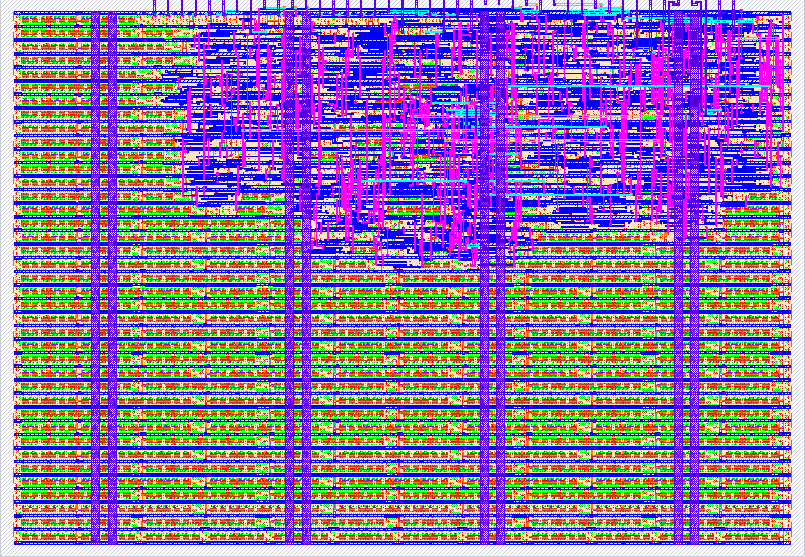550 PWM Generator
550 : PWM Generator

- Author: Shyam Sunder Mandapally
- Description: PWM Generator with demux logic
- GitHub repository
- Open in 3D viewer
- Clock: 10000000 Hz
10-bit PWM with Demux Logic
Institution: FH Kärnten
Course: Digital-1
Program: Integrated Systems & Circuit Design
How it works
This design is a 10-bit PWM generator with a compact configuration demux and simultaneously update mechanism.
PWM core
A 10-bit up-counter runs from 0 to reload_active.
On the clock where cnt = set_active, the output goes high.
On the clock where cnt = clr_active, the output goes low.
When cnt = reload_active, the counter wraps to 0.
Control truth table
- sel="00" + wr=1 → write SET shadow with data_i
- sel="01" + wr=1 → write CLEAR shadow with data_i
- sel="10" + wr=1 → write RELOAD shadow with data_i
- commit=1 → copy all shadows to actives in the pwm_module
Frequency and duty (plain text formulas):
-
PWM frequency = f_clk / (reload + 1)
-
High time (for set < clr) = (clr - set) / (reload + 1) of the period
-
If set > clr, the high window wraps around the end of the period.
Config demux + double buffering
Three shadow registers (set_shadow, clr_shadow, reload_shadow) are written via a single shared 10-bit bus:- sel = "00" → write SET
- sel = "01" → write CLEAR
- sel = "10" → write RELOAD
- wr = 1 stores data_i into the selected shadow.
- commit = 1 copies all shadows into the active registers (*_active) in the same clock edge.
(Same-cycle wr=1 and commit=1 is supported: the just-written value is applied.)
Reset/enable
Internally, reset is gated with ena (res_ni_g <= rst_n and ena), so the design stays in reset while the tile isn’t enabled.
TinyTapeout pin map (10-bit data path)
pin map (10-bit data path)
- ui_in[7:0] → data_i[7:0] (LSBs)
- uio_in[5:4] → data_i[9:8] (MSBs)
- uio_in[1:0] → sel (00=SET, 01=CLEAR, 10=RELOAD, 11 ignored)
- uio_in[2] → wr (1-cycle strobe)
- uio_in[3] → commit (1-cycle strobe)
- uo_out[0] ← pwm_o (active-high PWM). Other uo_out bits are 0.
- uio_out is driven 0 and uio_oe is 0 (uio pins used as inputs only).
Note: reload must be ≥ 1. If reload = 0, the counter would stall (the RTL asserts a sim-time warning).
How to test
-
Bring the core out of reset
- Hold ena = 1 and rst_n = 1. Keep uio_in[3:0] low until you’re ready to program.
-
Program the three fields (example for ~9.77 kHz @ 10 MHz clk, 50% duty)
- Target values: reload = 1023, set = 0, clear = 512.
- Data bus wiring: data_i[9:8] = uio_in[5:4], data_i[7:0] = ui_in[7:0].
Write RELOAD
- Put data_i = 1023 (0x3FF): set uio_in[5:4]="11", ui_in="11111111".
- Set sel="10" → uio_in[1:0]="10".
- Pulse wr: uio_in[2]=1 for one clock, then back to 0.
Write SET
- Put data_i = 0: uio_in[5:4]="00", ui_in="00000000".
- sel="00", pulse wr for one clock.
Write CLEAR
- Put data_i = 512 (0x200): uio_in[5:4]="10", ui_in="00000000".
- sel="01", pulse wr for one clock.
Commit Simultaneously
- Pulse commit: uio_in[3]=1 for one clock.
-
Observe the output
- uo_out[0] toggles with period 1024 / fclk and ~50% duty in this example.
-
Inputs type for different Requirements
- Increase duty: raise clear (for set=0 case).
- Shift phase: move set away from 0.
IO
| # | Input | Output | Bidirectional |
|---|---|---|---|
| 0 | data_i[0] (LSB) | pwm_o (active-high PWM) | sel[0] |
| 1 | data_i[1] | sel[1] | |
| 2 | data_i[2] | wr (strobe) | |
| 3 | data_i[3] | commit (strobe) | |
| 4 | data_i[4] | data_i[8] | |
| 5 | data_i[5] | data_i[9] (MSB) | |
| 6 | data_i[6] | ||
| 7 | data_i[7] |